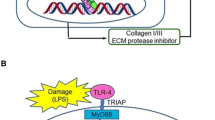Abstract
Objective: To explore the possibility of reverting HBV-related hepatic fibrosis and cirrhosis with traditional Chinese medicine (TCM).Methods: A herbal recipe (861), comprising of 10 herbs includingSalvia miltiorrhiza, Astragalus membranaceus andSpatholobus saberectus were used as the antifibrotic agents. Three controlled clinical trials of treating HBV-related fibrosis and early cirrhosis were carried out. A total of 107 patients were assessed clinically and pathologically with double liver biopsies before and after treatment by means of modified Scheuer and Chevallier scoring system. Rat model of hepatic fibrosis induced by CC14 and human albumin immune injury, culture of separated hepatic stellate cells (HSC) were established. Total collagen content of the liver was determined by detection of hydroxyproline, amount of type I, III, IV collagens by histoimmunochemistry, quantitative measurement of mRNA for collagen I, III, IV, transforming growth factor-β (TGF-(3), matrix metalloproteinase (MMP1), MMP2, tissue inhibitor of metalloproteinase (TIMP) in liver tissue by dot blot hybridization. Serum and liver tissue collagenase activity was detected by method of Rajabi M and Emonard H. Histopathological study of liver specimen was done with H. E., Masson and sirius red stain as well as histoimmunochemistry.Results: (1) In HBV-related patients, after six months treatment with 861, the reversion rate was as high as 78% in S2, 82% in S3 (precirrhotic stage) and 75% in S4 (cirrhosis). These results correspond well with that obtained in animal experiment. (2) Total and type I, III, V collagen content in animal model liver were significantly reduced in amount after 861 treatment, whereas quantitation of mRNA for collagen I, III, V and TGF-β were also markedly suppressed either in liver tissue or cultured HSC, suggesting the suppression by 861 on fibrogenesis. At the same time, serum and liver tissue collagenase activity (latent and active) were enhanced significantly by administration of 861, while mRNA for MMP1 (interstitial collagenase) in cultured HSC and collagenase activity in the supernatant of the HSC culture were both increased, and meantime, mRNA for TIMP1 was significantly suppressed in quantity, indicating the enhancement of excessive extracellular matrix (ECM) degradation after 861 treatment.Conclusions: (1) Contrary to the conventional concept, the liver fibrosis and early cirrhosis due to HBV infection in man could be definitely reversed by TCM treatment of 861. This was also verified in CCI4 and immune injury models. (2) The mechanism leading to the reversal of fibrosis was due to suppression of fibrogenesis, and the concurrent enhancement of ECM degradation. In the latter, suppression of TIMP also plays an important role. (3) Both initiation by imflammation and perpetuation of the activation of HSC were suppressed by the 861.
Similar content being viewed by others
References
Greenwel P, Geerts A, Ogata I, et al. Liver fibrosis. In: Arias LM. Boyer JL, Fausto N. et al. editors. The liver: biology and pathobiology. 3rd ed. New York: Raven Presss, 1994:1367–1381.
Sherlock S, Dooley J. Diseases of the liver and biliary system. 9th. ed. Oxford: Blackwell Sci Pub, 1997:351.
Scott L. Friedman. Hepatic fibrosis. In: Schiff ER, Sorrell MF, Maddrey WC, eds. Diseases of the Liver. 8th. ed. New York: Lippincott-Raven Pub, 1999:371.
1990; 21(4): 23–25.
1997; 5(2): 77.
1998; (2): 148.
861 1999; 7(1): 36.
1989; 69: 503–505.
1993; 1(2): 69–72.
1983; 6: 133.
Friedman SL, Roll FJ. Isolation and culture of hepatic lipocyte, Kupffer cells and sinusoidal endothelial cell by density gradient centrifugation with stractan. Anal Biochem. 1987; 161: 207–208.
Emonard H, Grimaud JA. Active and latent collagenase activity during reversal of hepatic fibrosis in murine schistosomiasis. Hepatology 1989; 10:77.
Rajabi M, Dean DD, Woessner JF. High levels of serum collagenase in premature labor-A potential biochemical marker. Obstet Gyncol 1987; 69:179.
1995 1995; 34: 788–791.
Chevallier M, Guerret S, Chossegros P, et al. A histological semiquantitative scoring system for evaluation of hepatic fibrosis in needle liver biopsy specimens: comparison with morphometric studies. Hepatology 1994; 20:349.
Sun M, Wang BE, et al. Two rat models of hepatic fibrosis: A morphology and molecular comparison. Lab. Invest 1990; 63: 467–475.
861 I, JV TGF-β mRNA 1996; 4(4): 214.
861 1996; 4(3): 142.
Ma H, Wang BE, Ma XM. The effect of compound 861 on hepatic stellate cell (HSC) proliferation, collagen synthesis and degradation in vitro. J Gastroenterol Hepatol 1997; 12(suppl): S97.
1997; 4(2): 56.
861 1998; 3(3): 172.
Author information
Authors and Affiliations
Rights and permissions
About this article
Cite this article
Baoen, W., Tailing, W., Jidong, J. et al. Experimental and clinical study on inhibition and reversion of Liver fibrosis with integrated Chinese and western medicine. CJIM 5, 6–11 (1999). https://doi.org/10.1007/BF02934179
Issue Date:
DOI: https://doi.org/10.1007/BF02934179




